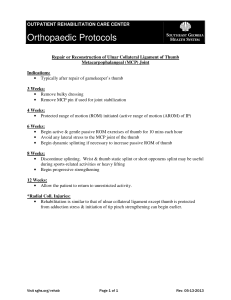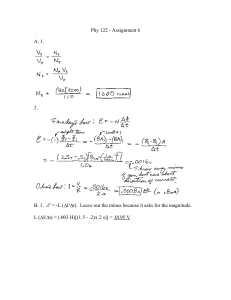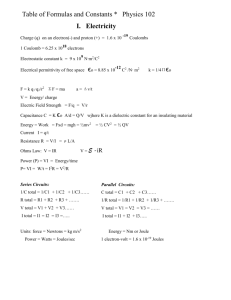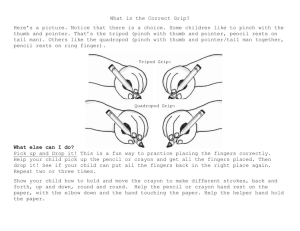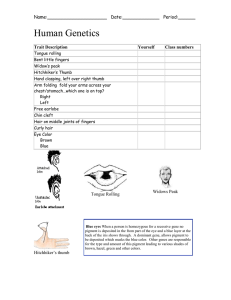The Hand
advertisement
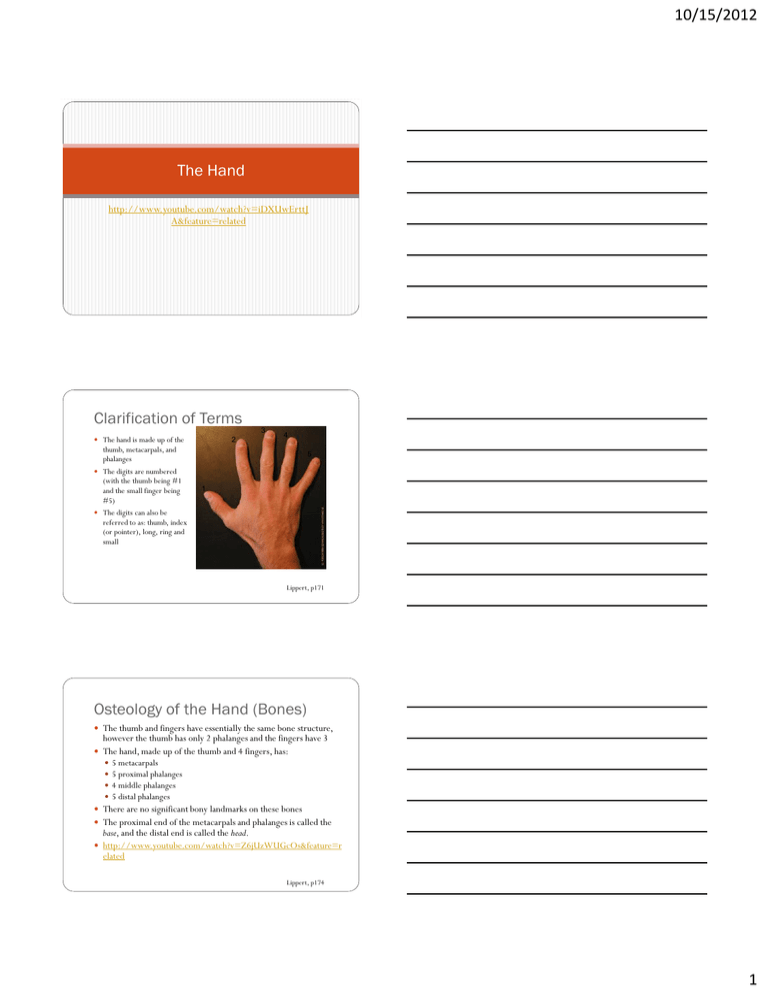
10/15/2012 The Hand http://www.youtube.com/watch?v=iDXUwErttJ A&feature=related Clarification of Terms 3 The hand is made up of the 2 4 thumb, metacarpals, and phalanges 5 The digits are numbered (with the thumb being #1 and the small finger being #5) The digits can also be referred to as: thumb, index (or pointer), long, ring and small 1 Lippert, p171 Osteology of the Hand (Bones) The thumb and fingers have essentially the same bone structure, however the thumb has only 2 phalanges and the fingers have 3 The hand, made up of the thumb and 4 fingers, has: 5 metacarpals 5 proximal phalanges 4 middle phalanges 5 distal phalanges There are no significant bony landmarks on these bones The proximal end of the metacarpals and phalanges is called the base, and the distal end is called the head. http://www.youtube.com/watch?v=Z6jUzWUGcOs&feature=r elated Lippert, p174 1 10/15/2012 Osteology of the Hand (Bones) Hand: Joint Structure Each of the 5 digits contains 1 metacarpal and a group of phalanges A ray = one metacarpal and its associated phalanges Carpometacarpal (CMC) joints = articulation between proximal end of a metacarpal and the distal row of carpal bones Metacarpophalangeal (MCP) joints = articulation between the distal ends of the metacarpals and the proximal phalanges Each finger has 2 interphalangeal (IP) joints = a proximal interphalangeal (PIP) and a distal interphalangeal joint (DIP) The thumb has only 2 phalanges and therefore only one interphalangeal joint (IP joint) Mansfield, p146 Hand: Joint Structure…cont Distal Interphalangeal Joints (DIP) Interphalangeal Joints (IP) Proximal Interphalangeal Joints (PIP) Metacarpophalangeal Joints (MCP) Carpometacarpal Joints (CMC) 2 10/15/2012 Hand: Joint Structure…cont Arches of the hand: Observe the natural arched curvature of the palmar surface of your relaxed hand Control of this concavity allows the human hand to securely hold and manipulate objects This palmar concavity is supported by 3 integrated arch systems: Proximal and distal transverse arches Longitudinal arch Mansfield, p148 Thumb: Joint Structure The first digit, the thumb, has 3 joints: The carpometacarpal (CMC) joint Articulation between the trapezium and the base of the first metacarpal Saddle joint: each articular surface is concave in one direction and convex in the other (much like a pringles potato chip) The metacarpophalangeal (MCP) joint The interphalangeal (IP) joint Lippert, p171 Thumb: Joint Movement Osteokinematics: CMC: flexion & extension, abduction & adduction, opposition & reposition MCP: flexion and extension IP: flexion and extension Arthrokinematics: 3 10/15/2012 Thumb: Joint Movement…cont CMC osteokinematics review: Flexion / Extension Occur in a plane // to the palm (frontal plane) Abduction / Adduction Occur in a plan perpendicular to the palm (sagittal plane) Opposition / Reposition Opposition is a combination of flexion and abduction, with accessory rotation Reposition is the return to anatomical position Lippert, p172 Fingers: Joint Structure The second, third, fourth and fifth digits (index, long, ring, and small fingers) each have 4 digits: CMC MCP PIP DIP Lippert, p173 Fingers: Joint Structure…cont CMC Joints: Nonaxial plane (irregular) synovial joints Provide more stability than mobility Articulation between: Trapezium & base of 1st metacarpal (thumb) Trapezoid & base of 2nd metacarpal (index) Capitate & base of 3rd metacarpal (long) Hamate & base of the 4th metacarpal (ring) Hamate & base of the 5th metacarpal (small) Lippert, p173 4 10/15/2012 Fingers: Joint Structure…cont MCP Joints: Layman’s term = knuckles Biaxial condyloid joints Convex heads of metacarpals articulate with the base of the proximal phalanges, which have a concave shape Two IP Joints: PIP and DIP are uniaxial hinge joints Lippert, p173 Fingers: Joint Movement Osteokinematics: CMC: 2nd and 3rd CMC are not mobile, 4th CMC slightly mobile, 5th CMC allows for a small amount of small finger opposition (but nearly as much as the 1st CMC of the thumb) MCP: flexion, extension, hyperextension, abduction and adduction IP (PIP & DIP): flexion and extension Arthrokinematics: MCP: convex moving on concave IP: convex moving on concave Lippert, p173 Fingers: Joint Movement…cont Osteokinematics of the MCP joints: The middle finger is the point of reference for abduction and adduction Abduction occurs when the 2nd, 4th and 5th fingers move away from the 3rd finger. Abduction also occurs when the 3rd finger moves in either direction Adduction occurs when the 2nd, 4th, and 5th fingers return from abduction and move toward the 3rd finger. There is no adduction of the middle (3rd) finger, only abduction occurring in either direction Lippert, p173 5 10/15/2012 Hand: Supporting Structures Wrist Flexor Retinaculum: ligament spanning the entire anterior surface of the wrist, holds flexor tendons close to the wrist when the wrist flexes. It also acts as a “tie beam” preventing the carpal bones from spreading apart. Extensor Retinaculum: ligament spanning the posterior aspect of the wrist, holding the wrist extensor tendons close to the wrist during extension CMC Capsule: connective tissue surrounds and stabilizes the CMC joints MCP, PIP, & DIP Capsule: connective tissue surrounds and stabilizes the joints Radial & Ulnar Collateral Ligaments: limit abduction and adduction Fibrous Digital Sheaths: form tunnels or pulleys for the extrinsic finger flexor tendons; contain synovial sheaths to help lubrication MCP only Volar Plates: ligaments cross palmar surface of each MCP joint limiting hyperextension Deep Transverse Metacarpal Ligaments: wide flat ligaments that loosely binds the 2nd through 5th metacarpals Lippert, p174 & Mansfield, p151, 153, 156 Myology of the Hand (Muscles) Extrinsic Muscles: Anterior: Flexor Digitorum Superficialis (FDS) Flexor Digitorum Profundus (FDP) Flexor Pollicis Longus (FPL) Posterior: Abductor Pollicis Longus (APL) Extensor Pollicis Brevis (APB) Extensor Pollicis Longus (EPL) Extensor Digitorum (ED) Extensor Indices (EI) Extensor Digiti Minimi (EDM) Anatomic snuff box Lippert, p176 Myology of the Hand: Extrinsics Flexor Digitorum Superficialis Origin Common flexor tendon on the medial epicondyle of the humerus, coronoid process of the ulna and radius lateral to the bicipital tuberosity Insertion By 4 tendons, each to the sides of the middle phalanges of the fingers Innervation Median n. Action MCP and PIP flexion “tidbit” What’s in a name? 6 10/15/2012 Myology of the Hand: Extrinsics Flexor Digitorum Profundus Origin Anterior ulna and interosseous membrane Insertion By 4 tendons, each to the base of the distal phalanx of digits 2-5 Innervation Medial half: Ulnar n. Lateral half: Median n. Action MCP, PIP and DIP flexion, wrist flexion “tidbit” What’s in a name? Myology of the Hand: Extrinsics Flexor Pollicis Longus Origin Middle anterior portion of the radius and interosseous membrane Insertion Base of the distal phalanx of the thumb Innervation Median n. Action CMC, MCP and IP flexion of the thumb “tidbit” What’s in a name? “Anatomic Snuff Box” Extensor Pollicis Longus Extensor Pollicis Brevis ABDuctor Pollicis Longus 7 10/15/2012 Myology of the Hand: Extrinsics ABDuctor Pollicis Longus Origin Posterior surface of the radius, ulna and interosseous membrane Insertion Base of the 1st metacarpal Innervation Radial n. Action ABD and extension of the CMC of the thumb “tidbit” What’s in a name? Myology of the Hand: Extrinsics Extensor Pollicis Brevis Origin Posterior aspect of the radius and interosseous membrane Insertion Dorsal base of the proximal phalanx of the thumb Innervation Radial n. Action Extension of the MCP & CMC joints of the thumb “tidbit” What’s in a name? Myology of the Hand: Extrinsics Extensor Pollicus Longus Origin Posterior surface of the ulna and interosseous membrane Insertion Dorsal base of the distal phalanx of the thumb Innervation Radial n. Action Extension of the IP, MCP and CMC of the thumb “tidbit” What’s in a name? 8 10/15/2012 Myology of the Hand: Extrinsics Extensor Digitorum Origin Lateral epicondyle of the humeruscommon extensor tendon Insertion By 4 tendons, each to the base of the extensor mechanism and base of the proximal phalanx of all 4 fingers Innervation Radial n. Action Extension of the fingers “tidbit” What’s in a name? Myology of the Hand: Extrinsics Extensor Indicis Origin Posterior surface of distal ulna and interosseous membrane Insertion Blends with the index tendon of the extensor digitorum Innervation Radial n. Action Extension of the index finger “tidbit” What’s in a name? Where would we be without the extensor indicis? 9 10/15/2012 Myology of the Hand: Extrinsics Extensor Digiti Minimi Origin Ulnar side of the belly of the extensor digitorum Insertion Joins the tendon of the extensor digitorum to the little finger Innervation Radial n. Action Extension of the 5th finger “tidbit” What’s in a name? How would you drink tea if you didn’t have a EDM? Myology of the Hand (Muscles) Intrinsics: Thenar: Flexor Pollicis Brevis (FPB) Abductor Pollicis Brevis (APB) Opponens Pollicis (OP) Deep Palm: Adductor Pollicis (AP) Dorsal Interossei Palmar Interossei Lumbricals Hypothenar: Flexor Digiti Minimi (FDM) Abductor Digiti Minimi (ADM) Opponens Digiti Minimi (ODM) Lippert, p181 10 10/15/2012 Myology of the Hand: Intrinsics Thenar Eminence Myology of the Hand: Intrinsics Thenar Muscles Muscle Action Innervation Flexor Pollicis Brevis Flexes the CMC & MCP of the thumb Median Nerve (C6, C7) Abductor Pollicis Brevis Abducts the CMC of the thumb Median Nerve (C6, C7) Opponens Pollicis Opposes the CMC of the thumb Median Nerve (C6, C7) Lippert, p181-182 Myology of the Hand: Intrinsics Deep Palm Muscles Muscle Action Innervation Adductor Pollicis Adducts CMC of thumb Ulnar Nerve (C8, T1) Dorsal Interossei Abduct MCP of fingers Ulnar Nerve (C8, T1) Palmar Interossei Adduct MCP of fingers Ulnar Nerve (C8, T1) Lumbricals Flexes MCP joints while extending PIP & DIP joints 1st & 2nd lumbricals – medial nerve 3rd & 4th lumbricals – ulnar nerve Lippert, p182-184 11 10/15/2012 Myology of the Hand: Intrinsics Hypothenar eminence Myology of the Hand: Intrinsics Hypothenar Muscles Muscle Action Innervation Flexor Digiti Minimi Flexes CMC and MCP of small finger (5th) Ulnar Nerve (C8, T1) Abductor Digiti Minimi Abducts the MCP joint of small finger (5th) Ulnar Nerve (C8, T1) Opponens Digiti Minimi Opposes the 5th finger Ulnar Nerve (C8, T1) Lippert, p184-185 Strengthening the Hand 12 10/15/2012 Hand Function Functional Position of the Hand: Wrist in slight extension MCP & PIP in some degree of flexion Thumb is in opposition. Lippert, p189 Hand Function…cont The primary function of the human hand is prehension: to hold or manipulate objects Power Grips: Cylindrical grip Spherical grip Hook grip Precision Grips Pad-to-pad grip Tip-to-tip grip Pad-to-side grip Side-to-side grip Lumbrical grip Lippert, p189-192 Hand Function: Power Grips Power grip Significant amount of force Most powerful grip Fingers flex around an object in one direction and the thumb wraps around in the opposite direction providing counterforce to keep the object in contact with the palm and/or fingers. 3 types Cylindrical, spherical & hook Lippert, p189 13 10/15/2012 Hand Function: Power Grips Cylindrical Grip: All fingers are flexed around the object which is usually at a right angle to the forearm. The thumb is wrapped around the object, often overlapping the fingers. Lippert, p190 Hand Function: Power Grips Spherical Grip All of the fingers and the thumb are ADDUcted around an object, and unlike the cylindrical grip, the fingers are more spread apart. The palm of the hand is often not involved. Lippert, p190 Hand Function: Power Grips Hook Grip: Involves the second through fifth fingers flexed around an object in a hooklike manner. The MCP joints are extended, and the PIP and DIP joints are in some degree of flexion. The thumb is usually not involved. Lippert, p190 14 10/15/2012 Hand Function: Precision Grips Tend to hold the object between the tips of the fingers and thumb. Involves intrinsics and extrinsics Thumb is ABDucted Fine movement & accuracy Objects are small or fragile, no palm involvement, no movement of proximal joints 5 main categories: Pad to pad, tip to tip, pad-to-side, side-to-side & lumbrical grip Lippert, p194 Hand Function: Precision Grips Pinch Grip MCP and PIP of the fingers are flexed, thumb is ABDucted and the distal joints of both are extended bringing the pad of the finger(s) and thumb together. Pinch grip: with thumb and one finger Three-jaw chuck: thumb and two fingers Lippert, p191 Hand Function: Precision Grips Tip-to-tip grip: bring tip of thumb up against the tip of another digit, usually the index finger, to pick up a small object such as a coin or a pin AKA: pincer grip Very difficult with long nails Lippert, p191 15 10/15/2012 Hand Function: Precision Grips Pad-to-side grip (aka lateral prehension) Pad of the extended thumb presses an object against the racial side of the index finger Hand Function: Precision Grips Side-to-side grip: Requires ADDuction of 2 fingers, usually the index and middle fingers Weak grip and does not permit much precision Lippert, p191 Hand Function: Precision Grips Lumbrical Grip: Sometimes referred to as the plate grip MCP and PIP joint flexed and the DIP joint extended the thumb opposed the fingers holding and object horizontal. The lumbricals flex the MCPs while extending the IP joints Lippert, p192 16 10/15/2012 Common Wrist & Hand Pathologies Colles’ Fracture: Transverse fracture of distal radius with a posterior displacement of the distal fragment due to FOOSH Smith’s Fracture: Transverse fracture of distal radius with an anterior displacement of the distal fragment due to a fall on the back of the hand Carpal Tunnel Syndrome: Compression of the medial nerve within the carpal tunnel causing numbness, tingling, and weakness in hand Lippert, p186-187 Common Wrist & Hand Pathologies DeQuervain’s Tenosynovitis: Inflammation of tendons of and the sheath containing the APL & EPB causing radial sided pain Dupuytren’s Contracture: Palmar aponeurosis thickens and causes flexion contractures mostly in the pinky and ring fingers Skier’s Thumb: Acute tear of the ulnar collateral ligament of the thumb Lippert, p186-187 Common Wrist & Hand Pathologies Swan Neck Deformity: Flexion of the MCP joint, hyperextension of the PIP joint, and flexion of the DIP joint. Boutonniere Deformity: Extension of the MCP joint, flexion of the PIP joint and extension of the DIP joint Ulnar Drift: Ulnar deviation of the fingers at the MCP joints Lippert, p186-187 17 10/15/2012 Certified Hand Therapists Hand specialists study and treat the hand exclusively to be considered hand therapists. Most clinicians refer patients with diagnoses of the hand to a hand therapist. What is expected? Osteology Extrinsic myology Familiarity with the intrinsic myology by names of the muscles Familiarity with the overall function of the structures intrinsically and extrinsically Common injuries and potential causes Identify! -Flexor digitorum superficialis -Flexor digitorum profundus -Flexor pollicis longus Identify! Extensor digitorum Extensor digiti minimi Extensor indicis ABDuctor pollicis longus Extensor pollicis brevis Extensor pollicis longus 18 10/15/2012 References Lippert, L.S. (2011). Clinical Kinesiology and Anatomy, 5th ed. Philadelphia, PA: F.A. Davis. Mansfield, P.J., & Neumann, D.A. (2009). Essentials of Kinesiology for the Physical Therapist Assistant. St. Louis, MO: Mosby Elsevier. 19
